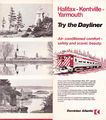Dominion Atlantic Railway Digital Preservation Initiative - Wiki
Use of this site is subject to our Terms & Conditions.
Category:RDC
Dominion Atlantic Railway Rail Diesel Cars
Self propelled Budd RDCs (rail diesel cars) passenger cars called "Dayliners" in C.P.R. vernacular. The DAR's Dayliners provided the Evangeline named passenger service beginning in 1956.
The first two Dayliners on the DAR, No. 9058 and No. 9059, the only two lettered as Dominion Atlantic Dayliners, have been assigned DARxxxx pages. The rest have been assigned CPRxxxx or VIAxxxx pages as these units seemed to have wandered in and out of service on the D.A.R. at the pleasure of the C.P.R. and VIA Rail.
The first day of Dayliner service was on Monday the 20th of August 1956.[1][2] The first East bound RDC left at 11:00 and the first West bound RDC left at 11:10.
On October 29, 1978, Via took over operation of CP passenger train services, and took possession of cars and locomotives.[3]
Budd RDC Technical Details
RDCs were powered in Phase I by two (one for each truck) GM 275 HP and later in Phase II two GM 300 HP two-stroke slant 6 diesel motors on a carriage slung under each side of the middle of the car. The distintive humps on the roof were the radiators and exhaust. The Allison transmission sported a torque-converter for acceleration and deacceleration and locked up a direct drive clutch once the RDC was at operating speed. Direction was handled by clutching in either one of two constant mesh helical gears to the transmission drive shaft. Each wheel (8 in all) had its own disk brake.[4]
Exclusive in Canada to Canadian Pacific RDCs was the installation of the Pyle Gyralights at each end of the car.
Canadian Pacific was also well known for the use of their high-visibility "Warpaint" (striped) and "Hockey Mask" (abstract striped) end paint schemes.
Canadian Pacific only operated the RDC-1 models, both Phase I and Phase 2 on the Dominion Atlantic.
It would not be until VIA Rail took over that RDC-2 and RDC-4 models could be spotted running the D.A.R.
Budd RDC, Phase I
Phase I RDC's were built from 7/1949 to 9/1955.[5] The most noticeable features were: windows on the ends of cars were larger than on Phase II, the pilot was not flush mounted, headlights were mounted immediately above the doors. The position of the headlight created a problem for railways which used diaphragms. CN and later VIA addressed this problem by fabricating a headlight and number board assembly which was mounted on the cab roofs. CP did not use diaphragms, so this was not a problem. During the CP era, some of the Phase I cars were fitted with smaller cab windows. Once VIA took possession of the CN and CP cars, all received smaller cab windows.
CP Phase I RDC-1 cars were numbered 9049-9057.
Gallery of Selected Examples on the D.A.R.
No. 9050 at Yarmouth Station on the old engine house siding in September 1979.
Budd RDC, Phase II
The prototype Phase II RDC was introduced in 1956.[4] Changes included smaller windows on the ends of the cars, a flush pilot, restroom windows omitted, changes to the radiator screen on the roof, cast trucks, wheel diameter increased from 33 to 34 inches, an increase from 275 to 300 hp, roof over cab changed to a more curved design with a raised housing for headlights, number boards moved from the sides to above cab windows, and upgraded air conditioning. [4][6]
CP RDC-1 Phase II cars were no's 9058-9072.
Gallery of Selected Examples on the D.A.R.
Interior Views
Interior of No. 9058 in the Kentville Car Shop after collision with a Burro Crane at Coldbrook, Oct. 30, 1965.
Interior of RDC VIA No. 6119 on the last eastbound, Yarmouth to Halifax passenger run, Train No. 154, January 14, 1990.
Cab of RDC VIA No. 6145 at Yarmouth, having just arrived with last passenger train on the DAR. Engineer is believed to be Willis Forsythe, January 14, 1990.
Cab of RDC VIA No. 6145 at Yarmouth, having just arrived with last passenger train on the DAR, January 14, 1990.
Willis Forsythe in cab of RDC VIA No. 6145 at Yarmouth, having arrived with the DAR's last passenger train, January 14/15, 1990.
References & Footnotes
- ↑ Donaldson, Ian: Dayliner Service Arrives, Chronicle-Herald August 16, 1956
- ↑ Advertisement. Dayliner Service Starts, Chronicle-Herald August 20, 1956
- ↑ Wikipedia, The formation of Via Rail Canada
- ↑ 4.0 4.1 4.2 Donald Duke and Edmund Keilty, RDC: The Budd Rail Diesel Car, pgs. 56-62, 85
- ↑ Crouse, Chuck. Budd Car: The RDC Story. 1990. The Weekend Chief Publishing Company. pp. 153-165.
- ↑ Crouse, Chuck. Budd Car: The RDC Story. 1990. The Weekend Chief Publishing Company. p. 17.
External Links
Pages in category "RDC"
The following 29 pages are in this category, out of 29 total.





















